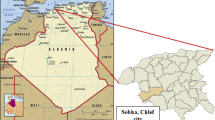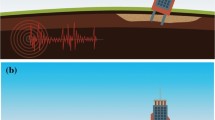Abstract
The stability of foundations soils could represent a clear and present threat for the conservation of even well preserved buildings, particularly for Architectural heritage conservation and land art heritage. A dramatic case is the presence of collapsible metastable sands as foundation soils, as it occurs in the sacral complex Valle dei Templi in Agrigento. This site listed by UNESCO, stands on a crest of a calcarenite cuesta, overlaying a layer of these sands. When the collapsible sand is dry, the structure is strong enough to bond the sand particles together. When the sand becomes wet, a de-structuration mechanism occurs and the soil’s strength is compromised. This paper has a twofold aim: (1) to gain a better understanding of the kind of bonding forces between the textural components of the collapsible metastable sand and (2) to identify a proper consolidant, that could combine the compatibility of inorganic systems and the performance of polymeric materials, paying attention to the environmental issues related to this site. Soaking tests have been performed by submerging sand samples in different solvents in order to verify the role of water menisci in mechanical stability of the sand highlighting a perfect stability using a non polar solvent. Sand samples have been consolidated by using poly ethylene glycol and nanosilica. Oedometer tests on consolidated and untreated samples have been used to verify the reduction of collapse potential induced by the treatment with the proposed mixtures.










Similar content being viewed by others
Abbreviations
- CP:
-
Collapse potential
- Cu :
-
Uniformity coefficient
- e0 :
-
Initial void ratio
- ef :
-
Final void ratio
- Id :
-
Durability index
- Ip :
-
Plasticity index
- n:
-
Porosity
- wl :
-
Liquid limit
- wp :
-
Plastic limit
- Wp :
-
Polymer content is equal to: (weightfinal − weightinitial)/weightinitial
- δd :
-
Parameter related to dispersive forces
- δh :
-
Parameter related to hydrogen bonding
- δp :
-
Parameter related to the polar bonds
- εv :
-
Vertical strain (ΔH/H0)
- σ′v :
-
Vertical stress
References
Nocilla, N., Ercoli, L., Zimbardo, M., Nocilla, A., Meli, P., Grado, G., Parello, G., Presti, G.: Unsaturated sand in the stability of the cuesta of the Temple of Hera (Agrigento). In: Geotechnical Engineering for the Preservation of Monuments and Historic Sites—Proceeding of the 2nd International Symposium on Geotechnical Engineering for the Preservation of Monuments and Historic Sites, pp. 603–611 (2013)
Ercoli, L., Zimbardo, M., Nocilla, N., Nocilla, A., Ponzoni, E.: Evaluation of cliff recession in the Valle dei Templi in Agrigento (Sicily). Eng. Geol. 192, 129–138 (2015)
Nocilla, N., Zimbardo, M., Ercoli, L., Nocilla, A., Ponzoni, E.: Collapsible soils and instability processes in the Valle dei Templi (Agrigento). Rivista Italiana di Geotecnica. 49(1), 65–78 (2015)
Cotecchia, V., D’Ecclesiis, G., Polemio, M.: La dinamica dei versanti della Valle dei Templi di Agrigento. Geologia applicata e idrogeologia Bari, vol. XX (1995)
Zimbardo, M., Ercoli, L., Megna, B.: The open metastable structure of a collapsible sand: fabric and bonding. Bull. Eng. Geol. Environ. 75(1), 125–139 (2016)
Collins, K., McGown, A.: The form and function of microfabric features in a variety of natural soils. Géotechnique 24(2), 223–254 (1974)
Alonso, E.E., Gens, A., Hight, D.W.: Special problem soils, general report. In: Proceedings of 9th European Conference on Soil Mechanics and Foundation Engineering, vol 3, pp. 1087–1146 (1987)
Franzen, C., Mirwald, P.W.: Moisture content of natural stone: static and dynamic equilibrium with atmospheric humidity. Environ. Geol. 46, 391–401 (2004)
Mellors, T.W.: The influence of the clay component in loess on collapse of the soil structure. In: Dijkstra, T., Smalley, I.J. (eds.) Genesis and Properties of Collapsible Soils. Springer, Dordrecht (1995)
Ma, Y., Lv, L., Guo, Y., Fu, Y., Shao, Q., Wu, T., et al.: Porous lignin based poly(acrylic acid)/organo-montmorillonite nanocomposites: swelling behaviors and rapid removal of Pb(II) ions. Polymer (Guildf) 128, 12–23 (2017)
Wang, X., Liu, X., Yuan, H., Liu, H., Liu, C., Li, T., Yan, C., Yan, X., Shen, C., Guo, Z.: Non-covalently functionalized graphene strengthened poly(vinyl alcohol). Mater. Des. 139, 372–379 (2018)
Hu, C., Li, Z., Wang, Y., Gao, J., Dai, K., Zheng, G., Liu, C., Shen, C., Song, H., Guo, Z.: Comparative assessment of the strain-sensing behaviors of polylactic acid nanocomposites: reduced graphene oxide or carbon nanotubes. J. Mater. Chem. C 5, 2318–2328 (2017)
Stone, T.T., Dickel, D.N., Doran, G.H.: The preservation and conservation of waterlogged bone from the Windover Site, Florida: a comparison of methods. J. Field Archaeol. 17(2), 177–186 (1990)
Johnson, J.S.: Consolidation of archaeological: a conservation perspective. J. Field Archaeol. 21(2), 221–233 (1994)
Scaffaro, R., Lopresti, F., Maio, A., Botta, L., Rigogliuso, S., Ghersi, G.: Electrospun PCL/GO-G-PEG structures: processing–morphology–properties relationships. Compos. A Appl. Sci. Manuf. 92, 97–107 (2017)
Scaffaro, R., Maio, A., Lopresti, F., Giallombardo, D., Botta, L., Bondì, M.L., Agnello, S.: Synthesis and self-assembly of a PEGylated-graphene aerogel. Compos. Sci. Technol. 128, 193–200 (2016)
Unger, A., Schniewind, A.P., Unger, W.: Conservation of Wood Artifacts a Handbook. Springer, Dordrecht (2001). ISBN 3-540-41580-7
Scaffaro, R., Lopresti, F., Botta, L., Rigogliuso, S., Ghersi, G.: Integration of PCL and PLA in a monolithic porous scaffold for interface tissue engineering. J. Mech. Behav. Biomed. Mater. 63, 303–313 (2016)
Barkman, L.: The preservation of the warship Wasa. In: Oddy, W. (ed.) Problems of the Conservation of Waterlogged Wood, pp. 65–106. National Maritime Museum, Greenwich (1975)
Hoffmann, P.: The conservation of the Bremen Cog—the final years. In: Hoffmann, P, Spriggs, J., Grant, T. (eds.) Proceedings of the 8th ICOM Group on Wet Organic Archaeological Materials Conference, pp. 27–48. ICOM, Stockholm (2001)
Pearson, C.: The use of polyethylene glycol for the treatment of waterlogged wood—its past and future. In: VriesZuiderbaan, L. (ed.) Conservation of Waterlogged Wood, pp. 51–55. Netherlands National Commission for UNESCO, The Hague (1979)
Zhang, J.-X., Liang, Y.-X., Wang, X., Zhou, H.-J., Li, S.-Y., Zhang, J., Feng, Y., Lu, N., Wang, Q., Guo, Z.: Strengthened epoxy resin with hyperbranched polyamine-ester anchored graphene oxide via novel phase transfer approach. Adv. Compos.and Hybrid Materials 1(2), 300–309 (2018)
Kango, S., Kalia, S., Celli, A., Njuguna, J., Habibi, Y., Kumar, R.: Surface modification of inorganic nanoparticles for development of organic–inorganic nanocomposites—A review. Prog. Polym. Sci. 38(8), 1232–1261 (2013)
Scaffaro, R., Maio, A.: A green method to prepare nanosilica modified graphene oxide to inhibit nanoparticles re-aggregation during melt processing. Chem. Eng. J. 308, 1034–1047 (2017)
Kyung Kim, E., Won, J., Do, J., Dug Kim, A.: Effects of silica nanoparticle and GPTMS addition on TEOS-based stone consolidants. J. Cult. Herit. 10, 214–221 (2009)
De Ferri, L., Lottici, P.P., Lorenzi, A., Montenero, A., Salvioli-Mariani, E.: Study of silica nanoparticles—polysiloxane hydrophobic treatments for stone-based monument protection. J. Cult. Herit. 12, 353–363 (2011)
Zimbardo, M., Ponzoni, E., Nocilla, A., Ercoli, L.: Resistenza e collasso strutturale di una sabbia parzialmente satura. In: Incontro Annuale Ricercatori Geotecnici Genova (2018)
American Society for Testing and Materials (ASTM): Soil and Rock; Dimension Stone; Geosynthetics; Annual Book of ASTM Standards, (408): 1092 (1990)
ASTM D422-63(2007)e2, Standard Test Method for Particle-Size Analysis of Soils (Withdrawn 2016): ASTM International, West Conshohocken (2007)
ASTM D4318-17e1, Standard Test Methods for Liquid Limit, Plastic Limit, and Plasticity Index of Soils: ASTM International, West Conshohocken (2017)
Hansen, C.M.: Hansen Solubility Parameters: A User’s Handbook (http://books.google.com/books?id=gprF31cvT2oC&printsec=frontcover). CRC Press (2007). ISBN 0-8493-7248-8
Jennings, J.E., Knight, K.: A guide to construction on or with materials exhibiting additional settlement due to collapse of grain structure. In: Proceedings 6th African Conference on Soil Mechanics and Foundation Engineering, pp. 99–105 (1975)
ASTM D5333-03: Standard Test Method for Measurement of collapse potential of Soils (Withdrawn 2012). ASTM International, West Conshohocken (2003)
Scaffaro, R., Lopresti, F., Sutera, A., Botta, L., Fontana, R.M., Puglia, A.M., Gallo, G.: Effect of PCL/PEG-based membranes on actinorhodin production in Streptomyces coelicolor cultivations. Macromol. Biosci. 16, 686–693 (2016)
Ceraulo, M., Morreale, M., Botta, L., Mistretta, M.C., Scaffaro, R.: Prediction of the morphology of polymer-clay nanocomposites. Polym. Testing 41, 149–156 (2015)
Acknowledgements
This work has been financially supported by the PRIN program within the project “Monitoraggio, consolidamento, conservazione e protezione dei beni culturali n. 2015WBEP3H” and carried out within a cooperation protocol between the DICAM department and the “Parco Archeologico e Paesaggistico della Valle dei Templi” authority. We are gratefully with Prof. Nicola Nocilla, for the useful suggests during the development of the research and the critical revision of the manuscript and with Dr. Erasmo Cataldo for the CAD drawing of the oedometer cell.
Author information
Authors and Affiliations
Corresponding author
Ethics declarations
Conflict of interest
The authors declare that they have no conflict of interest.
Rights and permissions
About this article
Cite this article
Margherita, Z., Laura, E., Bartolomeo, M. et al. Collapsibility of metastable sand by non-conventional oedometer tests. Granular Matter 21, 1 (2019). https://doi.org/10.1007/s10035-018-0854-6
Received:
Published:
DOI: https://doi.org/10.1007/s10035-018-0854-6




